
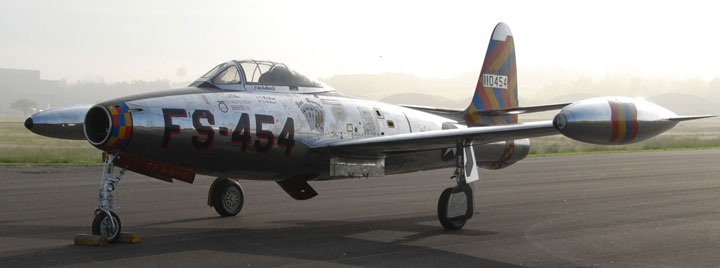
A Thunderjet on the tarmac in Halifax, Nova Scotia. All photos provided by Orin Humphries.
By Orin Humphries
2012
Five years ago, I studied the straight wing Republic F-84E Thunderjet as a possible CL modeling subject. When it became obvious that I had bitten off a huge project with my F2G Drawings thing, I put that aside and got out my F-84 stuff so I could get something into the air sooner. In 2009 I had made the life's dream trip to the National Archives and the Smithsonian's aviation archive at their National Air and Space Museum. I got a ton of drawings, screen prints of microfilmed factory drawings, of four airplanes including the F-84E.
Your time in the research room at the NASM Archive is so limited you have to “fly.” I didn't know until I got home that the coverage on the F-84E was very thin in the wing area. The surprisingly results of the trip is the subject of another article I could write and you have to read it before you make this fabled trip. It is not good.
The scale of my F-84 was chosen by finding the largest wingspan I could get into the trunk of my Mustang. This came out to be 1/12 scale. Later, when I had the complete propulsion system in my hands, the wing loading came out to high and I had to upsize to 110% of that, leaving me with a really strange scale.
The source in the beginning of this project was to be the three-views in Squadron Signal F-84 book. If I actually finished this model, the plan was to buy a license from the copyright owner. Six months into the drawing of the enlarged top and side views, trouble started showing up. The wing and horizontal tail on one side of the tip view were longer than those on the other side. The panel lines on the fuselage in the top and side views were at different distances from the nose.
I bought a copy of the Koku-fan F-84 drawings and enlarged the top view, again, planning to buy a license if successful. Sadly, I found that the scale of the wing in this view was one number, and the scale of the wing was a different one by a measurable amount, and the scale of the horizontal tail was still a third, unique scale. Later, I found that details like the aileron cutout in the wing skin were a “looks about right” affair. I made the difficult and now-questionable decision to scrap the six months of drawing progress and make my own views from scratch.
The drawing coverage from the NASM as said was incomplete. The wing ribs are in three pieces, front, middle and rear. There was no complete rib at any wing station, and no piece outboard of middle of the wing at the end of the flap. A drawing had located the inboard ends of the two spars exactly, but I had nothing telling me where the outboard ends wound up. Of the two sources for guessing this, one had serious problems of distortion and the other was a leap of faith. I went with the latter and built the wing complete with landing gear mounts and bellcrank platform.
When I tried to lay out the ailerons and flaps, the project blew up in my face. The outboard end of the rear spar was too far aft and would be cutting off the leading edge of the two movable surfaces. Argh!
What to do? I could just ignore it and finish the airplane, losing notable fidelity points and hurting the marketability of the plans. I could use the TLAR method that most commercial three-views seem to do. But I am making my own three-view, so I have to justify everything to the Scale Board at AMA. My final alternative would be to cut away the rear spars, trim the ribs to a new length, make new rear spars and glue them in. I shelved the project and put out requests for more information to several sources. That was early April this year, 2012.
I had been working long and hard so I took a break awaiting better information. I finished up two plastic Army tank kits I had started years ago and which had been staring at me from inside the closet. Come May 24th, Jan and I left for a long-planned vacation to Nova Scotia. I had found an ad for a tour of Atlantic Canada in the Smithsonian Magazine last winter. We would ride a bus while touring Nova Scotia, Cape Breton Island, Prince Edward Island, and New Brunswick for 11 days.
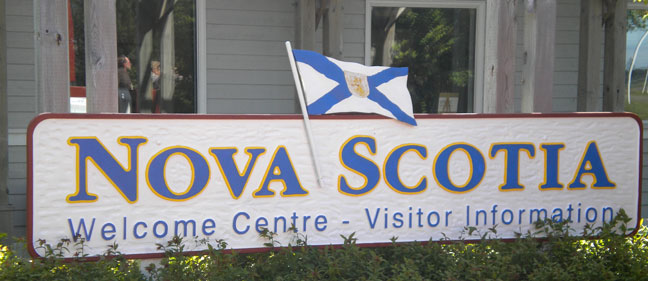
We arrived a day early at the airport near Halifax and over-nighted near the airport. Waiting for the tour meeting that would be in the evening, we went to the Atlantic Canada Aviation Museum near the motel. It was a great collection! I introduced myself as a volunteer aircraft restorer at the Museum of Flight in Seattle, and the volunteer guide at this museum and I had a great chat about this life.
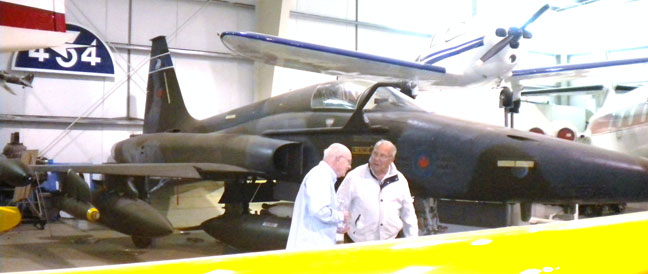
Orin (left) with a volunteer at the Atlantic Canada Aviation Museum.
It was just fantastic to see a famous part of the Atlantic Canada coast. We were on a bus with 44 other people, so we didn't have to worry about how to get anywhere in a strange place. The guide told us things about the region that we would not have heard from store clerks. We went through a region on Cape Breton Island where the descendants were all Irish and the road signs were in English and Gaelic. By the way, “Celtic” is pronounced “keltic” instead of “seltic”. Further up the road, the descendants were French and everything was in English and French. We went whale watching at a town called Cheticamp, a French name. We had a great lobster dinner there. Then we went to Prince Edward Island, PEI.
While on PEI, on our first jaunt, we were driving toward our next stop when I spotted something unbelievable out in a farmer's yard. You know that my F-84 project has been stalled because I mislocated the rear spar too far aft at the wingtip. On my side of the bus, I looked out at what was the tip tank and remnant of the wingtip of what seemed to be a straight wing F-84! It was displayed on a simple stand to keep it up out of the grass.
I thought, “How cruel Life is to show me precisely the thing I need to measure to get the project going again, and I can't get at it”. All I really needed was the distance from the trailing edge to the rear spar. As we drove I figured the odds of just having seen this thing. Later I worked out the math and it literally came out at one million to one. What if I had been on the other side of the bus that morning? What if the tank was one county road over from our road, etc? All day long I tried to come up with some work around plan to get measurements once I got back home. Near the end of the day I approached our driver, a local named Lorne, and told him of my predicament with the model. He said, “I know where that tank is. Meet me here at the bus after my last shuttle run at 8:00 and I will take you there.”
I couldn't believe my luck after the life I have had! Lorne borrowed the motel owner's car, believe it or not. He drove me there in a light rain and there was only a pair of tire tracks in the sod to get from the road to the houses. I asked about the occupants of them and, being a local, he knew they were occupied only during harvest. I hiked in to the yard where the tank sat and noted some curious, small differences between this tank and the one to be on my mode.
First, the vane on the rear end wasn't triangular. It had been made with a trimmed off outer end. There was an extra, racetrack-shaped maintenance access panel on the outboard side of the tank that mine doesn't have. The navigation light on the leading edge at the juncture with the tank was never built in. There was a fourth that I can't remember just now. That bothered me, but the tank had other features which assured it had been made by the same sub-contractor for maybe different companies. I went ahead and measured anyway as it was just so similar, hoping I could resolve the question later.
It was difficult to figure which feature inside the downward sloping wing stub was the rear spar and which was the front spar, etc. I couldn't see up in there. I had to reach in blindly and feel around, hoping a cold spider wouldn't chomp me. Actually, I am not offended that the spiders didn't consider me exactly gourmet food. I can live with that.
I was glad I had the permanent ink pens so I could draw sketches and make note on slightly wet paper. I got back to the car and Lorne asked me if it was the right airplane. I reassured him his trouble had not been for naught. I didn't want to face that I could come this close and miss even in the face of unbelievable odds. Nor could I bring myself to tell Lorne his trouble might have been for nought. Back at the motel, I thanked the owner for the use and the next morning I offered to get him some gas. Still, I just could not think of any airplane this could be from that was not an F-84.
Later on our tour I spotted a picture in a museum of another American airplane that was sold to the Canadians, the F2H-3 Banshee. Remember my profile carrier model of the Banshee in the 1980s? It was dark sea blue with white markings. That picture at the museum really dropped my spirits.
We were driving through Charlottetown and they have a golf course with the longest sand trap in the world. It runs the entire length of one of the holes (I am not a golfer; what do you call that strip, the “fairway”?) There was a sign by the clubhouse that read, “Players are required to wear two pairs of socks when on this course”. We asked the guide what that was about. (Prepare yourselves, folks…) “That is”, she replied, “in case you get a hole in one ... ” Yeah, our foreheads felt just like yours does right now. Sorry.
While on Cape Breton Island, we visited the Alexander Graham Bell Museum. I didn't know that he was born in Scotland, raised in Britain, and lived much of his life in Canada. He had built a huge hydrofoil powered by two look-like-Liberty engines. He tried to make it the new thing, but hydrofoils didn't work out, then. The craft is at this museum near Baddeck, Cape Breton Island.
We drove across the Federation Bridge, 11km long, and entered New Brunswick. Presently we arrived at the Bay of Fundy. That bay sports the highest tides in the world, sometimes reaching the 50-60 foot range during “king tides”. We hustled along the beach on a tour after the water went out before our eyes. We stepped right along as it would soon be back in.
Remember the old Mamas and the Papas song? “Fundy, Fundy; can't trust that bay ... ” Okay, I will behave myself from here on out. Promise.
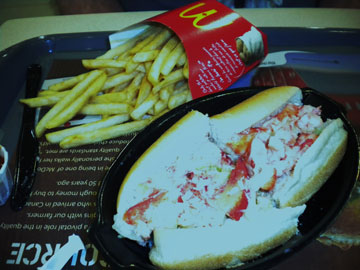 We spent the night in Halifax. The tour the next day took us to the big fort, the Citadel, on the hill overlooking the harbor. After they fired the signal cannon, a black powder muzzle loader at noon, we headed down the hill for individual walk abouts. Jan and I toured their huge Public Gardens and then headed for McDonalds for lunch. The guide had told us early on that they served a “McLobster sandwich.” I have not broken my recent promise. They actually did, and it cost $6.99 Canadian. Maybe the editor will have room here to include the picture of that sandwich (Editor's note: Yep -- it's at right).
We spent the night in Halifax. The tour the next day took us to the big fort, the Citadel, on the hill overlooking the harbor. After they fired the signal cannon, a black powder muzzle loader at noon, we headed down the hill for individual walk abouts. Jan and I toured their huge Public Gardens and then headed for McDonalds for lunch. The guide had told us early on that they served a “McLobster sandwich.” I have not broken my recent promise. They actually did, and it cost $6.99 Canadian. Maybe the editor will have room here to include the picture of that sandwich (Editor's note: Yep -- it's at right).
After lunch we stumbled onto an old fashioned hobby shop. There was an old slow pattern stunter hanging from the ceiling. I bought a motor and gearbox by Tamiya for a future project and some things for my next tank, to be done sometime down the road. I left with a bit of an ache for bygone days in hobby shops.
When I got home, I found an e mail saying the reason I hadn't received an answer for more drawings from the NASM was that my letter had been misplaced and forgotten. He apologized and put it in work. I drove around the north end of Puget Sound and hit all the hobby shops, looking for a book on the Banshee or a kit. None had anything. I did see an expensive kit of the F-84G (Mine is a -E) and I bought it the next day to get measurements off of it. A plastic model is a very untrustable source of data, preaching to the choir, here, but I bought it out of desperation. That was a great move! It showed me another mistake I was making before I glue any wood together, justifying the money no matter the other outcome.
The cover on the nose gun bay has rear edges that are not symmetrical. On the right side, the cover falls straight down, but on the left side, it falls straight for a bit and then slopes forward. I had assumed the edges or the gun bay cover would be symmetrical and drawing makers were making mistakes. It is a strange airplane.
Then I spent time on the web looking at pictures of Canadian 1950s airplanes. The coverage on the Web is thin and doesn't show the feature I want very well, but I could rule out some. Half of them had tanks that had cylindrical bodies instead of streamlined. The Panther's had a cylindrical center and too short a front end. To my joy, the Banshee's was mounted below the mid-line of the tank, too low to be the one I had found. And it didn't have the vane at the rear, I think. Yet, the web left the question unresolved.
My measurements of the kit figured well against the technical data from the Air Force, and it showed me the measurements I got in Canada were actually good! Once again searching the F-84 book from Squadron Signal, on the second try I found just one photo that showed the clipped vane tip and the extra access panel on the outboard side of the tank. It's on the -G sitting on a zero-launch rail with a rocket booster under the aft fuselage. You have to know what to look for and really want to see it, though. (Two nights ago, I discovered a strange tank of the airplane on the cover of the Sq. Sig. book. It has a cylindrical center body instead of streamlined, a slightly clipped vane tip, and no bolt covers on the top and bottom seems. “They” are messing with me ...).
My tank measurements are good, it was an F-84 tank, and last night I started to work out the chords of the aileron ends. The aileron area came out too large, strangely. It took a couple of days before I recalled that for this style of surface installation, only the area from the hinge line aft counts. Cranking that in, I arrived at the proper chord lengths for the ailerons. It jibed well with the skin cutout measurement I made in Canada.
Last night I started marking the new forward location for the rear spar. I have maybe two to three months of re-drawing and hacking out, and gluing in to get the wing squared away.
All this travail is because I have a perfectionist personality. Few commercial three-views are any good, but the rules say we can just use them and build a model of, well, “something”. The decision to make my own three-view cost me making it to the Regionals this year or any other contest with my F-84. This trouble has given me reason to start thinking about just building some of my future projects like everyone else does. That way I can actually finish one before I die. (I wish I had been born a lean, mean machine like Zoot Zoomer is instead of a perfectionist.)(Yeah, broke the promise.)

The wing under construction.
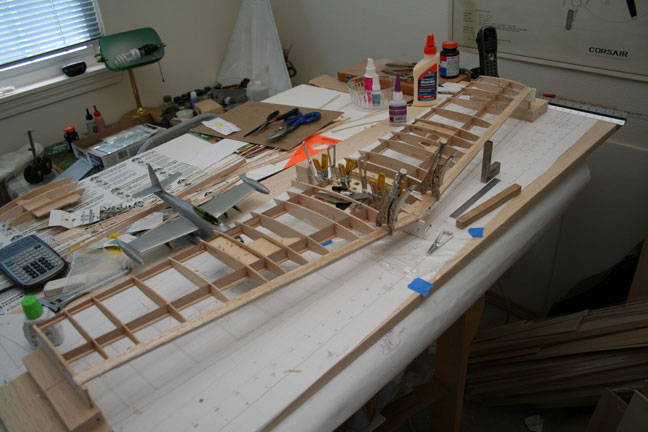
A small model on the workbench for inspiration.
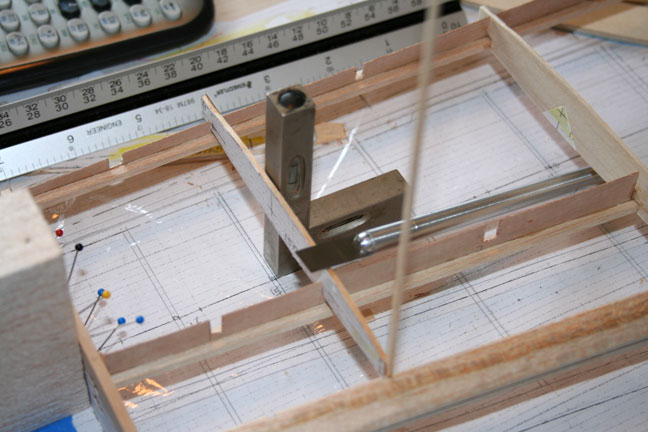
Construction detail.
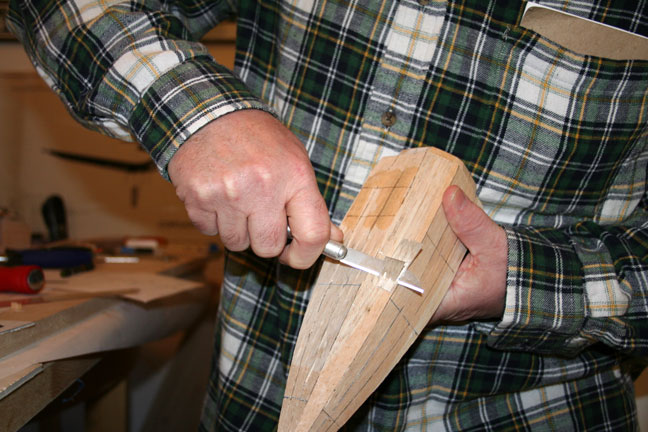
Carving the fuselage.
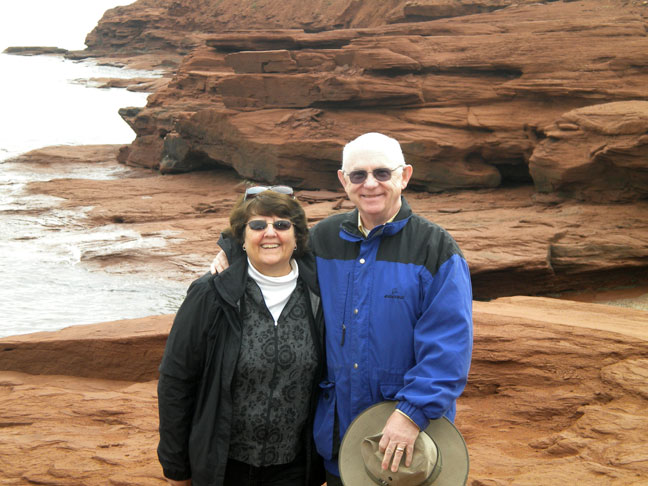
Orin and Jan in Nova Scotia.
This page was upated Nov. 22, 2014